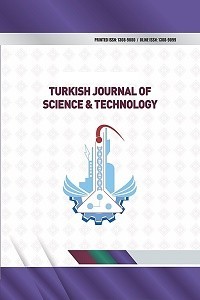The Effect of Aggregate Size and Cure Conditions On The Engineering Properties of Concrete
The Effect of Aggregate Size and Cure Conditions On The Engineering Properties of Concrete
Concrete, air cure water cure, slump,
___
- Referans1 Şimşek O. Beton ve beton teknolojisi. Seçkin Yayınları, 5. Baskı. Ankara, 2015.
- Referans2 Güçlüer K, Günaydın O, Tekin ÖF ve Şahan MF. Farklı tipte agrega kullanımının betonun mekanik özelliklerine etkisinin araştırılması. NÖHÜ Müh. Bilim. Derg. 2017; 6(1), 107-114.
- Referans3 Özel C. ve Kaplan AN. Kendiliğinden yerleşen beton özellikleri üzerinde agrega özelliklerinin etkisi. USMTD 2017; 1(1), 1-6.
- Referans4 Usta, S. Agrega Granülometrisinin Beton Bileşimindeki Teorik Malzeme Miktarları ile Betonun Kompasite ve Porozite Değerleri Üzerindeki Etkilerinin İncelenmesi. Yapı teknol. elektron. Derg. 2012; 8(1), 1-15.
- Referans5 Neville AM. Properties of concrete. London: Longman, 1995.
- Referans6 Özalp F, Şengül Ö, Taşdemir MA. Kür Koşulları ve Tecrit Malzemesinin Betonun Geçirimlilik ve Mekanik Özeliklerine Etkisi. THBB Derg. 2015; 69-74.
- Referans7 Özcan F, Atiş CD, Karahan O ve Bilim C. Silis Dumanının ve Kür Şartlarının Harç Basınç Dayanımına Etkisi. 2014; Tam metin bildiri: http://www.imo.org.tr/resimler/ekutuphane/pdf/11143.pdf.
- Referans8 TS EN 12390-3. Beton - Sertleşmiş beton deneyleri - Bölüm 3: Deney numunelerinin basınç dayanımının tayini. Türk Standartları Enstitüsü, Ankara, 2010.
- Referans9 ASTM C944/C944M-12 Standard Test Method for Abrasion Resistance of Concrete or Mortar Surfaces by the Rotating-Cutter Method. West Conshohocken, PA; ASTM International, 2012.
- Referans10 TS EN 12390-6. Beton - Sertleşmiş beton deneyleri - Bölüm 6: Deney numunelerinin yarmada çekme dayanımının tayini. Türk Standartları Enstitüsü, Ankara, 2010.
- Referans11 Yazıcıoğlu S, Demirel B, Gönen T ve Özer Ş. Farklı tip çimentoların betonun karbonatlaşmasına etkisi. UTBD 2012; 4(3), 112-120.
- Referans12 Kara C ve Yazicioglu S. Mermer tozu atığı ve silis dumanının betonun karbonatlaşma özelliğine etkisi. Bitlis Eren Univ J Sci 2016; 5(2), 191-202.
- Referans13 Baradan B ve Aydın S. Betonun Durabilitesi (Dayanıklılık, Kalıcılık). Beton 2013 Hazır Beton Kongresi; 2013; pp. 265-288.
- ISSN: 1308-9080
- Başlangıç: 2009
- Yayıncı: Fırat Üniversitesi
ANN-Based MPPT Algorithm for Photovoltaic Systems
A Control of SynRM using MPPT Algorithm and Effects of Advance Angle on Motor Performance
Güllü BOZTAŞ, Ömür AYDOĞMUŞ, Hanifi GÜLDEMİR
The Effect of Aggregate Size and Cure Conditions On The Engineering Properties of Concrete
Scenedesmus acutus’un Gelişim, Protein, Lipid ve Pigment Miktarı Üzerindeki Fotoperiyodun Etkisi
Nur AGIRMAN KAYMAZ, Ahmet Kadri CETİN
On the Robust Estimations of Location and Scale Parameters for Least Informative Distributions
Voltage Controlled Boost Converter-Inverter System for Photovoltaic Applications
Zeynep Bala DURANAY, Hanifi GÜLDEMİR
Design and Optimization of a PMSM for Obtaining High-Power Density and High-Speed
